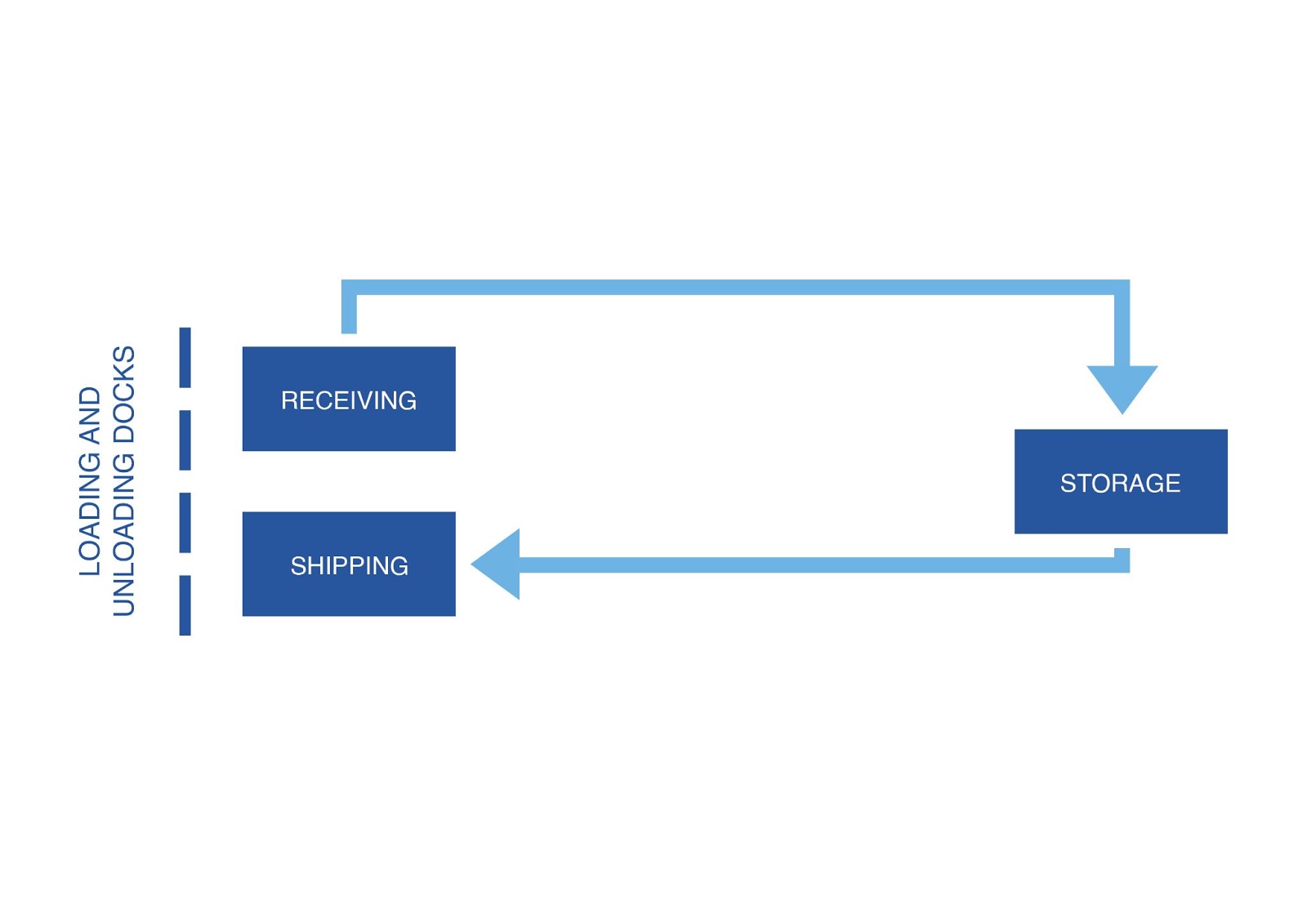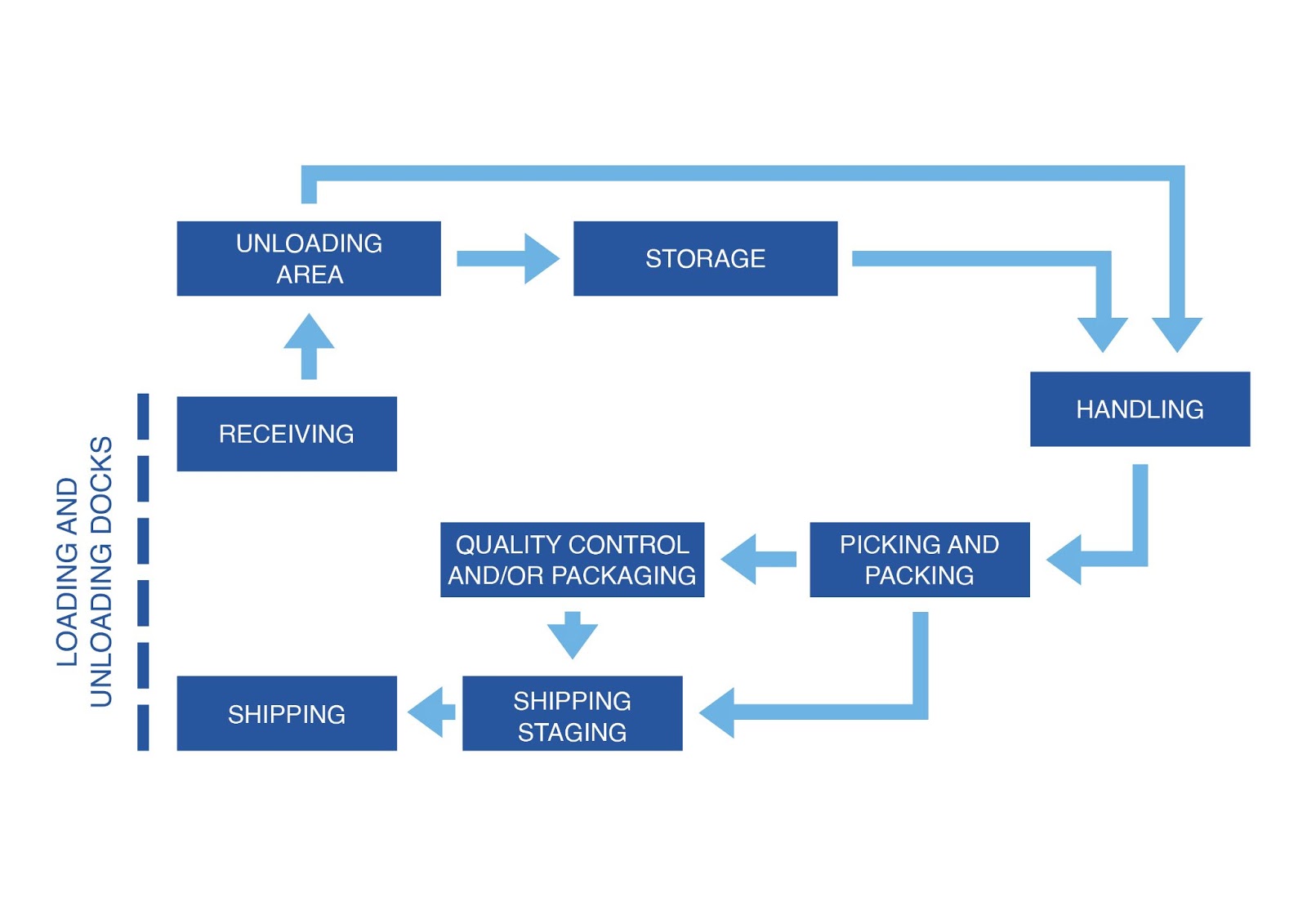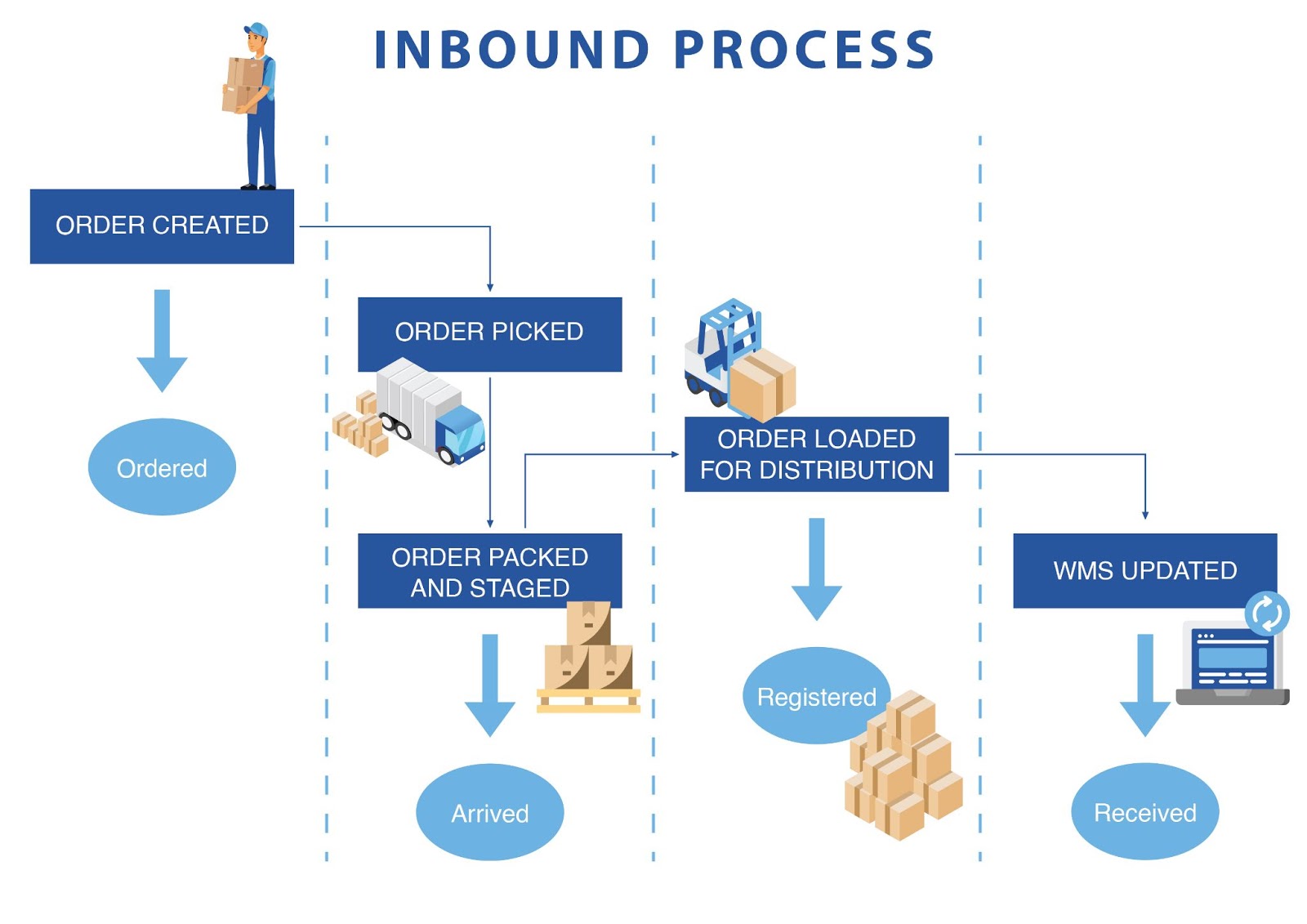Successfully running a warehouse is a pivotal element of any eCommerce business.
You need efficient product storage methods, skilled staff, relevant equipment and tools, and a speedy shipping timeline.

This warehouse management guide covers what warehouses are, warehouse functions, the types of workers you should employ, warehouse manager salaries, and ways to maximize warehouse efficiency.
What Is Warehouse?
A warehouse is a building that keeps products safe before they’re packed and shipped to customers. Warehouses are important for any business that sells physical products or works with suppliers from a wholesale marketplace. More space is needed to store products as a business’s revenue increases. You may work with numerous third parties as a result of your warehousing needs.
What Is Picking at a Warehouse?
Picking is identifying the right product for an order, getting it from the shelf, and bringing it to the packing table. There are often multiple pickers and packers in a warehouse. Warehouse pickers need to be accurate, as shipping correct orders reduces unwanted expenses. Sending out correct orders also simplifies the inventory management process.
What Are Value Added Services in a Warehouse?
A value added service is anything warehouse teams include in their process that goes beyond the paid requirements of work. This is often available in third-party logistics warehouses or large facilities.
Now that you’re acquainted with warehouse basics, it’s important to understand the functions of a warehouse. If you’ve never used a warehouse before, we’ll discuss the principles of warehousing that apply to any eCommerce business.

What Is Warehousing?
Warehousing provides the space you need to run a physical products business efficiently and profitably. Let’s take a closer look at some of the key functions of warehousing.
Functions of Warehousing
The process of warehousing includes controlling physical inventory, reordering, and maintaining products prior to sale. There are multiple principles of warehousing that allow warehouses to run smoothly and deliver great results for clients:
- Clear Objectives
You should know your warehouse’s purpose, location, type of goods held, lifespan, physical design, and partnerships before you start.
- Accuracy
Providing quality training for employees empowers them to pick accurately from day one.
- Operational Efficiency
Creating a one-way flow means all product that’s brought into the warehouse is only processed in one direction.
- Speed
More than half of consumers ages 18-34 expect same-day delivery. More than 60% of consumers are willing to pay more for same-day delivery.
- End-to-end customer satisfaction
Communication between delivery drivers, warehouse staff, and pickup drivers should be clear and concise.
- Tracking and reporting
By tracking and reviewing all phases of your warehouse activities, you can spot problem areas and implement relevant solutions.
Warehousing in Logistics and Supply Chain Management
Warehouses are only one element of supply chain management. Raw goods are first received at ports and later delivered to warehouses. From the warehouse, sold products either go to a manufacturer or a distributor, and are later delivered to the customer.
As you can see, small adjustments lead to significant differences in warehousing. This principle goes both ways, which is why it’s smart to conduct regular audit and maintenance schedules.
If you need help running your warehouse, hiring the right warehouse workers is an important next step. Up next in the warehouse management guide is a closer look at different warehouse jobs and the responsibilities associated with each.

What Is Warehouse Job?
If you’re applying for warehouse jobs or hiring workers for your own warehouse, you should be familiar with the types of warehouse work. Let’s look at different types of warehouse jobs and their associated responsibilities.
What Is a Warehouse Associate?
A warehouse associate is any staff member who handles daily needs throughout the warehouse. Associates are one of the most common job titles in the warehousing industry.
What Is a Warehouse Clerk?
Warehouse clerks oversee the materials, products, and shipments found in a warehouse. Depending on the warehouse size, a clerk may or may not handle picking and packing.
What Is a Warehouse Specialist?
A warehouse specialist handles daily operations and maintains regulatory compliance for tasks in a warehouse. They may or may not manage a team of warehouse associates, and sometimes report to managers or foremen.
What Is a Warehouse Technician?
A warehouse technician may operate a forklift, cherry picker, lift truck, or other specialized equipment. You may see multiple warehouse technicians under the guidance of a warehouse operator, foreman, coordinator, or specialist.
What Is a Warehouse Operator?
A warehouse operator may use equipment like pallet jacks and lift trucks, or they may run a loading dock. Warehouse operators sometimes work in conjunction with associates, or they may be the equivalent to an associate at a different warehouse.
As your business grows you’ll need to hire more staff and create teams. Getting skilled warehouse managers in place makes this much easier. Keep reading for information on warehouse manager job descriptions and salaries.
Warehouse Manager Job Description
Let’s look at the fundamental requirements of warehouse managers, as well as a sample resume and job description.
Warehouse Manager Job Description
A warehouse manager has a lot to oversee, regarding both employees and physical goods. The job description of a warehouse manager for your facility may include:
- Manage the warehouse in line with company’s standards
- Oversee basic operations, such as receiving, warehousing, distribution, and maintenance of products
- Utilize the warehouse space to achieve peak efficiency
- Safeguard warehouse operations with security procedures
- Maintain standards of health and safety, hygiene, and security
- Liaise with clients, suppliers and transport companies
- Seek out new suppliers using a wholesale directory
- Produce reports and statistics regularly (IN/OUT status report, dead stock report etc).
Warehouse Manager Job Qualifications
The best way to become a warehouse manager is through experience. You can progress quickly through a company by carrying out an apprenticeship after you leave school. Here are some basic requirements that everyone will need to be a warehouse manager:
- A high school diploma or GED
- A valid driving license
- A lift truck certificate of basic training
Warehouse Manager Resume Sample and Examples
Warehouse managers have resumes that may look similar to this one:

Skills
- Strong leadership skills and experience
- Effective problem-solving skills
- Multiple years of experience in a warehouse lead role managing hourly employees (normally a minimum of 3 years)
- Ability to work well with other people and in teams
- Proficient computer skills
- Available to work extended hours
Work Experience
The more relevant previous work experience you have with warehouses and their needs, the better. You can also try to get an industrial placement or work experience so you can fully experience the role. Obtaining general warehouse experience at first--perhaps as a trainee supervisor with a smaller organization--can lead to a management position down the road.
It’s a good idea to manage salary expectations accordingly. The next section details what average warehouse manager salaries look like for popular companies and locations.
Average Warehouse Manager Salary
A warehouse manager salary depends on multiple factors and circumstances. Some companies offer more compensation than others, whereas some products drive a higher profit margin, which is passed to employees.
The average warehouse manager salary falls around $53,500. The salary you get often depends on job experience and relevant know-how. It also depends on local cost of living, wage laws, and the company making the hiring decision.
Let’s look at the average compensation of specific warehouse manager roles.
Warehouse Operations Manager Salary
The average warehouse operations manager salary is $73,600.
Assistant Warehouse Manager Salary
Assistant warehouse manager salaries vary widely, but the average falls near $56,778.
Warehouse Manager Salaries by Company
To help inform your decisions on what salary to offer, here are some popular companies and their average warehouse manager salaries.
Amazon Warehouse Manager Salary
The average Amazon warehouse manager salary is $45,862.
Sysco Warehouse Manager Salary
The typical Sysco warehouse manager salary is $61,958.
UPS Warehouse Manager Salary
The average UPS warehouse manager salary is $43,500.
Warehouse Manager Salaries by Location
If you’re looking for a warehouse job in a different state or hiring staff for a new location, there’s a lot to be aware of. Let’s look at warehouse manager salaries for a couple locations.
Warehouse Manager Salary in Phoenix
The average warehouse manager salary in Phoenix, AZ, is $46,227.
Warehouse Manager Salary in Miami
A typical warehouse manager salary in Miami, FL, is $61,742.
Warehouse Manager Salary in Toronto
The average warehouse manager salary in Toronto, Canada, is C$71,894.
In addition to offering appealing positions and salaries in your warehouse, it’s important to know what you should train staff on. Most modern warehouses make use of a warehouse management system, or WMS. In the next section of our warehouse management guide, we’ll look at what this is and why you use one.
Warehouse Management System
A warehouse management system (WMS) collects and processes your eCommerce business data so you can achieve maximum leverage with your time. There are four different types of WMSs, each of which offers specific advantages.
Enterprise Resource Planning (ERP) Systems
ERP systems (see ERP meaning) are considered “umbrella” software that integrate all stages of your eCommerce business. This means everything from raw material origins to the final customer delivery. Consider the benefits of ERP in this situation.
Supply Chain Systems
A supply chain management system integrates all stages of operations, from importing raw goods through distribution and customer delivery. Supply chain management (SCM) allows you to monitor and improve areas like third-party relationships, purchasing, and distribution efficiency.
Cloud-Based Systems
A cloud-based WMS is software that provides warehouse management functions from a web-based platform. This type of WMS may be used by businesses that maintain high-value inventory or want more data security.
Standalone Warehouse Management Systems
Standalone systems provide features and reporting for warehouse operations, but not the stages before or after warehousing. A standalone warehouse management system is the simplest form of WMS.
Components of a Warehouse Management System
Each warehouse management system is designed to offer support and accuracy in at least four areas: receiving, inventory, fulfillment, and shipping.
Receiving Function
Your warehouse management system should have a module where you can view scheduled appointments, review incoming goods, print labels, and create receipts.
Inventory Management Function
The inventory module in your software will show you the date, time, quantity, location, and status of every individual unit.
Order Fulfillment Function
In the order fulfillment module, you can view confirmed orders, demand forecasting, ongoing picking and packing, tracking information, and any errors.
Distribution or Shipping Function
A shipping module is crucial for any warehouse management system, as customers depend on fast results year round.
The size or complexity of your warehouse may not demand a full WMS where inventory management software can get the job done. Let’s look at what warehouse inventory management software provides and how you can integrate it in your business.

Warehouse Inventory Management Software
Keeping products efficiently stored but able to be shipped out fast can be challenging. Thankfully, warehouse inventory management software minimizes the amount of manual labor workers need to complete.
Warehouse Inventory Management Software
Warehouse inventory management software is a program that enhances the storage, tracking, control, and replacement of inventory.
The two most important inventory management software features are inventory control and barcode scanning. Inventory control means product tracking, minimums and maximums, bin and shelf locations, and serial numbers.
The simplest way to update your stock quantity when packing and shipping products is by using a barcode scanner. If you don’t already use one, you can find affordable options through your inventory software company or online retailers.
Simple Warehouse Inventory Management
Striving for simple warehouse inventory management procedures is attainable, but it does require knowing your business’s needs. Here are the strategies to implement:
- Know the needs of your customers.
- Update your records frequently and check for errors.
- Use tools and software that benefit your type of business.
- Make excellent customer service your standard.
Warehouse Inventory Excel Template
If you’re just getting started with inventory management techniques there are numerous ways to accomplish your goals. Download our inventory Excel template for a solution you can implement right away (also Google Sheets compatible).
When all stock and equipment has its place, you can pack and fulfill orders quickly. Next, we’ll offer key layout principles and warehouse organization strategies you can implement today.
Warehouse Organization
It takes time and energy to create a warehouse layout and design that suits your business. Let’s examine popular warehouse organizational structures and how to optimize space in your facility.
Warehouse Layout Design
A warehouse layout design is the floor plan of your warehouse that’s created at scale. There are three different warehouse layouts that have become common over the years:
- U-shaped
This features receiving docks on one side of the building, with the unloading area, dynamic and static shelving, and packing area forming a U through the building.
- I-shaped
The I-shaped layout works well for large warehouses or companies that handle a large amount of orders. This structure is similar to U-shaped warehouses, but with receiving and shipping on opposite sides of the building.
- L-shaped
Shipping docks are placed on one side of the L with receiving docks on the other. Inventory, staging areas, and any offices are then placed in the corner opposing the L.
Warehouse Layout Optimization
No matter how long your warehouse has been operational, there is always something that can be improved. Here are some strategies to use:
- Provide enough physical space for people to do their work.
- Conduct periodic spot checks on shelving.
- Maintain a regular cleaning or janitorial schedule.
- Ask your employees about any improvement suggestions they have.
Having your layout down pat makes it easy for everyone in your warehouse to get their job done. The next step is creating and finalizing a warehouse management process flow.
Warehouse Management Process Flow
A well-thought-out warehouse management process flow reduces time and money on the daily. Let’s look at various types of process flow charts and how you can use them in your warehouse.
A warehouse management system process flow is an image depicting the order of actions in your facility. You can use various software programs to create a process flow, like Microsoft Excel or mind-mapping tools.
Here is a simple process flow chart example:

Here is a medium process flow chart:

Here is a complex process flow chart:

Warehouse Outbound Process Flow
The outbound process flow in your warehouse shows what each product goes through before dispatch. Your outbound flow should include these steps:
- Designate a packing area.
- Designate a shipping staging area.
- Monitor shipping and delivery notifications.
- Update your records.
Here is an example of an outbound process flow chart:

Warehouse Inbound Process Flow
Additionally, your inbound process flow dictates the steps incoming deliveries adhere to. Here are the steps your inbound process should include:
- Pre-schedule all deliveries.
- Ensure a clear and clean unloading area.
- Follow up with inventory management right away.
- Keep reports updated.
Here’s an example of what an inbound process flow looks like:

When a reliable warehouse process flow is in place, there’s no time wasted on guesswork. If your warehouse is due for a process upgrade or you’re expanding your facility, you may be looking at new labels. Here are our recommendations on warehouse labeling.
Best Warehouse Labels and Labeling Ideas
A warehouse labeling strategy that keeps efficiency and safety in mind simplifies all of your daily work. Keep reading to learn about what parts of your warehouse should be labeled, as well as our recommendations on high quality products.
Warehouse Rack Labels and Warehouse Rack Labeling Ideas
Racks are the shelves in your warehouse; usually they’re made out of steel or another type of metal. There are two normal approaches for warehouse rack labeling: standard labeling and serpentine labeling. Standard rack labeling means product label numbers all start at the same end of the rack.
Standard labeling looks like this:

Serpentine labeling means product label numbers wind around each corner of the rack. Each following product category is closest to the preceding number.
Serpentine labeling looks like this:

Warehousing experts recommend serpentine labeling for a couple reasons. It’s least likely to cause confusion about location, and workers don’t need to walk to the other side of a shelf when picking orders.

Best Warehouse Labeling Supplies
Using the right supplies helps everyone get their job done easier. If you’re opening a warehouse for the first time, you’re probably wondering what materials you need. We compiled a list of our favorite warehouse aisle and bin labels, label makers, tape, and label software. For the full list of these warehouse labeling supplies, check out these warehouse labels.
Now that you’re familiar with each dimension of warehouse management, you can take your eCommerce business to a new level. We hope our warehouse management guide helps you hire the right workers, improve daily efficiency, and astonish your customers.
BlueCart is a participant in the Amazon Services LLC Associates Program and makes commission through advertising and linking to Amazon.com.